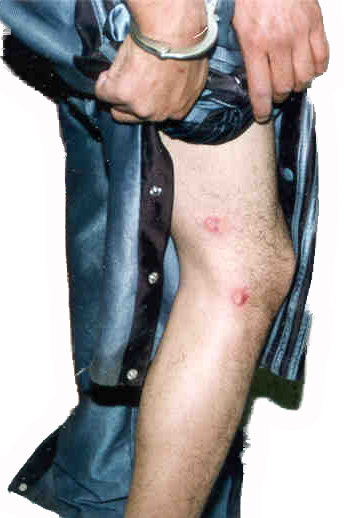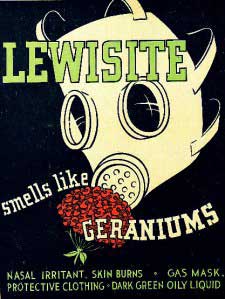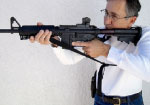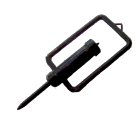When is less-lethal force appropriate?
A recent Department of Justice investigation slammed the Albuquerque Police Department for not holding officers' accountable for using this kind of force (Less-lethal). 6-14-2014
- A suspect armed with a knife, bludgeon, or rock.
- A suspect with a pistol in the waistband of his pants.
- Unruly or rioting crowds.
- An uncooperative individual that refuses to comply with police instructions.
- A mentally-altered suspect attempting “suicide by police”.
Should less-lethal munitions be used to take the above suspects into custody? Although each situation described is unique and must be viewed on its own merits, a few general concepts can be used to judge the appropriateness of the types of force used.

The term less-lethal is generally used to define a weapon or ammunition that may cause serious injury or death even when properly deployed, but is not specifically designed to be fatal. It is generally accepted that these types of tools will cause injury resulting, at a minimum, in an emergency room visit.
The term non-lethal is generally defined as a weapon, chemical or ammunition that will not cause serious injury and/or death when deployed properly. It may cause welts or eye watering but generally won’t require an emergency room visit.
Years ago, less-lethal munitions were introduced in situations where lethal force was justified as officers attempted to use less force in the hopes of saving the suspect’s life, and those agencies that employed less-lethal weapons were successful in achieving this goal. Although some suspects were accidentally killed by these less-lethal munitions, they were suspects on whom the officers could have justifiably used lethal force. As a result, public opinion was favorable as it was understood that the officers were using less-lethal munitions in an attempt to save lives.
For law enforcement personnel, the distinction between less-lethal and non-lethal force has blurred, and has diluted the meaning of less-lethal force options to the point that officers are relying on tools that are likely to cause serious injury and/or death in situations that call for far less force. These uses are leading to more and more serious injuries and litigation against law enforcement agencies2 . The United States Ninth Circuit Court of Appeals concluded in Deorle V. Rutherford 99-171881 that:
“Viewing the facts in the light we must, we conclude that, for purposes of summary judgment, Rutherford’s use of force was excessive and the defense of qualified immunity is unavailing. At a distance of 30 feet, Rutherford shot at a man who would have been better placed in a hospital than in custody. The degree of force was clearly in excess of the governmental interest at stake, and was used in circumstances that did not justify the failure to warn. There was no basis for any factual misperception and no reasonable officer could have concluded that the force employed was constitutional.”
Rutherford shot a mentally disturbed individual walking towards him at a distance of 30 feet with a beanbag round. The screaming suspect was advancing on the deputy, armed with a can of lighter fluid but no ignition source. The deputy gave no warning that he was going to shoot the suspect. The beanbag hit the suspect in the eye, taking it out.
Many agencies have written into policy that beanbag rounds are to be used as “extended range batons.” In addition, many less-lethal munitions manufacturers have advertised that their products, including beanbags3, tasers, stingballs, etc., should be used for riot control or crowd control4. For the most part, these are situations that require non-lethal, rather than the less-lethal force exerted by a beanbag round or a taser.
The term “beanbag” has helped foster this misunderstanding, as it leads people to believe that the bags are filled with beans when in fact the bags are generally filled with lead shot. If a bag breaks in flight, lead shot at 280-300+ feet per second is hurtling towards the suspect. At these speeds, the kinetic energy will cause the lead shot to penetrate the human body, much like a standard shotgun round.
When making an arrest, law enforcement officers are expected to use only the amount of force that is reasonable and necessary to control the circumstances they face. Officers and managers would prefer that the minimum level of force be used in all incidents; however, this is complicated by the misconceptions regarding the level of force their tools deliver.
How is force measured and what is the least amount of force in a given situation? Force must be measured by the amount of injury that it does to the suspect, the officer and any uninvolved persons in the area. Each department should develop a “matrix of force” based on their department’s experience with the force alternatives available to them, coupled with the regional and national uses of the same alternatives. As responsible individuals, they should make sure that all force usage is reviewed and meets the standards of reason and necessity for the circumstances in which it was utilized.
 Can officers morally and/or legally justify using force that is likely to produce serious injury or death against a crowd of people that are trying to exercise their first amendment rights? Can officers morally and/or legally justify the use of force that is likely to produce serious injury or death against persons that are not in a position to injure the officers, themselves, or someone else? Can officers justify using force likely to cause serious injury or death against persons that are doing no more than watching someone else participate in civil disobedience? The answer is no.
Can officers morally and/or legally justify using force that is likely to produce serious injury or death against a crowd of people that are trying to exercise their first amendment rights? Can officers morally and/or legally justify the use of force that is likely to produce serious injury or death against persons that are not in a position to injure the officers, themselves, or someone else? Can officers justify using force likely to cause serious injury or death against persons that are doing no more than watching someone else participate in civil disobedience? The answer is no.
If you, as a law enforcement professional, do nothing more as a result of this article, please review your use of force policies and make sure that you haven’t blurred the distinction between less-lethal and non-lethal force options. Increase your available tools so your officers and deputies have both non-lethal and less-lethal options available to them. Understand that having less-lethal and non-lethal alternatives doesn’t do the officer any good if the tools he or she needs are in a sergeant’s car or with a SWAT team. The patrol officer, when faced with a situation in which less-lethal or non-lethal use of force is appropriate, needs these tools  available immediately.
available immediately.
You must evaluate the less-lethal and non-lethal product(s) you are going to use and decide the truth for yourself. We recommend that you research any manufacturer’s claims to your own satisfaction. Remember, each manufacturer is trying to get your business. You must ask the company’s representatives questions based on your own knowledge of the products and your experience using force.
That knowledge should be a combination of:
- Kinetics: How hard an object will impact a suspect?
- Electronics: How much voltage and/or amperage can the human body take?
- Chemical agents: What are the characteristics of each chemical you are considering using?
- Court decisions: There are many recent decisions restricting or defining the use of force, and
If you are armed with this knowledge, you can make informed decisions and not rely on someone else’s opinions. This could become very important to if you have to defend your actions in court. A news article in the Los Angeles Times amplifies this thought. They report that the City of Huntington Beach, California is suing a less-lethal munitions manufacturer for making false claims as to the safety of their product after a suspect sustained near-lethal injuries from beanbags.5
If you find yourself sitting in front of a jury and your only response to a question is what the manufacturer told you, you will wish you had done your homework.
Dateline: Tucson - 4/10/2001
A university student who lost an eye after being injured during a riot was shot in the head by police with a bag of lead, authorities confirmed. Assistant Police Chief Roberto Villasenor said he didn't know how Jeff Knepper, 19, came to be shot in the head during the Tucson riot following the University of Arizona's loss in the NCAA championship on April 2. He said officers are trained to aim for the legs when using the ammunition, called "beanbags." "We would not try and fire at locations of the body where it could cause severe injury," Villasenor said. At least two people received head injuries from what police referred to as “non-lethal weapons” during the riot.
The Tennessean January 23, 2001
A beanbag bullet, 40 grams of buckshot gathered into a sock-like pouch and fired from a 12-gauge shotgun, is meant to immobilize, not kill. On Saturday night, however, such a projectile killed a Franklin County man, prompting a review by the Tennessee Bureau of Investigation and raising questions about the safety of the beanbag, a popular munitions alternative used by many Tennessee law officers. “We don't know why it happened. All we can say at this point is that it was a freak accident," said Capt. Tim Fuller of the Franklin County Sheriff's Department.
The Cincinnati Enquirer By Jane Prendergast and Michael D. Clark
Six of the Cincinnati Police Division's most well trained, elite officers are being investigated for their involvement in the Saturday shooting of beanbags into a crowd of peaceful protesters. According to witnesses, they sped to Liberty and Elm streets at around 4 p.m. Saturday after a call about a large crowd blocking the intersection, jumped out of their cruisers and fired without warning. They fired seven or eight times, witnesses say, then left in seconds. Two adults and two children were hit Saturday with the beanbags, less-than-lethal weapons Cincinnati police used to disperse crowds throughout last week's violence.
Beanbag rounds are projectiles enclosed in a heavy Cordura nylon and filled with pellets that can travel at 280 feet per second. They have a very high potential for injury and death and are not accurate. The effective range is 50 feet. To reduce the possibility of serious injury or death, the following standards of employment are recommended: At a distance of less than 10 feet, extreme caution should be exercised prior to deployment due to high possibility of fatal outcome. At distances of ten to twenty feet, avoid the head, neck, spleen, liver and kidney areas.
Police Practice Riot Response: An Innovative Approach By Ken Hubbs. “…With a level-four deployment, the team uses sound/flash diversionary devices (flashbangs) to gain the attention of the crowd, while aggressively advancing on the crowd and firing baton rounds and bean bags…”
Excerpt from The LA Times: “Police Dropping 'Non-lethal' Beanbags as Too Dangerous”
![]() June 3, 2002
June 3, 2002
By JACK LEONARD, Times Staff Writer
Attorneys representing the city contend that the company's beanbags nearly killed James Marvin Davis when officers tried to take him into custody.
The January 1999 incident began with a 911 call by Davis' fiancee, who complained that he was drunk and acting abusive. Officers ordered Davis out of his house. Davis, then 56, refused and stood in his doorway screaming.
Believing that he had a gun, an officer grabbed a beanbag shotgun and opened fire. "I felt thump, thump, thump to my chest. It felt like I was being punched," Davis recalled. "I had blood running down my arms.... I remember shouting, 'Look what you've done to me!'"
Three rounds bored through his chest, breaking two ribs and severing an artery. The bags had to be removed by surgeons.
While Davis recovered, police investigated the shooting. Police reports of the shooting scene suggest that the beanbags were fired from about 30 feet--a range that company literature deemed safe.
Davis is suing the department, which in turn has sued the manufacturer. The department alleges that the company failed to warn police adequately about the dangers of the bags. The company denies any wrongdoing.





